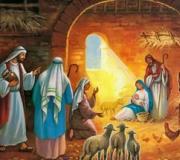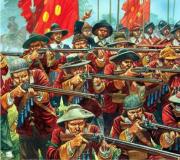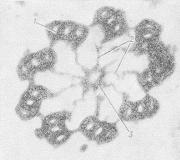Think about one of the heroes of the epics. Question: come up with a short work about one of the heroes of legends, fairy tales, epics
Every nation has epics, tales, myths or legends that go back to time immemorial. And they always have the strongest hero. We also have one - Svyatogor the hero. This is a fairy-tale hero of all Slavs, but the Rusyns consider themselves to be his direct descendants, and in their minds the Holy Mountains are the highest peak of the Carpathians. There, they believe, a fairy-tale giant still lives there, guarding order throughout the Slavic world.
“Svyatogor once lived among forests and wild mountains...”
Svyatogor the hero is one of the most ancient epic heroes, and the tales about him do not belong to either the Kiev or Novgorod cycles, although his paths intersect with both Ilya Muromets and Mikula Selyaninovich, the hero-plowman, the hero of Novgorod legends. There are many tales about the fabulous strongman-giant, with at least seven main stories. The information presented in them often varies, but the size of the hero and his extraordinary strength always remain unchanged. The main stories associated with Svyatogor are the incident with the saddle bag, which he cannot move, and the tragic death of the giant: according to one version, he, trying to at least lift the same knapsack, goes into the damp ground, according to another - immures himself alive in a stone coffin. Almost everywhere the fact is pointed out that due to his excessive weight, the “mother of Cheese Earth” could not bear him, so he did not leave the Holy Mountains, where he lived and after which he was named.

Lots of options
Other epics indicate a different reason for his immobility - he stood guard between Yav and Navy and could not leave his post. However, one day Svyatogor the hero decided to leave the border between Light and Darkness that he guarded. He went straight to heaven, building a staircase straight to the divine throne. This legend explains the hero's extraordinary strength. The Almighty was not angry with Svyatogor for his insolence, but, on the contrary, invited him to choose a wish that would be fulfilled. The giant asked for strength and wisdom; he did not know that the gods do nothing without intent. The hero really became stronger than everyone else, but he could not lift the lid of the stone coffin, in which he was buried alive. Often epics are superimposed on one another and it is impossible to understand how many wives Svyatogor had, for example, and why he was “divine” (though pre-Christian). Is it because he is the son of a deity (in some places the father is indicated as Rod, in others as Viy), or because he has been to heaven?
Analogies from epics of other peoples
According to one legend, he stood guard at a pillar supporting the sky, and in this case Svyatogor the hero resembles the Greek Atlas. In general, it should be noted that our epic giant is similar to some national heroes, like a twin brother. He especially has a lot in common with the Finnish hero named Kalevi-poega. They both live in rocky mountains, they both ford seas, and forests are like grass to them. Both have swords that no one but them can handle. Both one and the other in pictures illustrating epics are often depicted lying down: they really loved to sleep. Both Svyatogor and Kalevi-poega, possessing gigantic strength, at a certain moment cannot cope with an easy task: the first is to lift a small bag thrown by Mikula Selyaninovich from the ground, the second is to open a wooden door in the underground kingdom. Both of them have a blacksmith in their lives, and both of them are under the rule of fate. Svyatogor has a lot in common with the legendary giant strongman Samson. In this case, the interesting point is that the Jewish and Slavic heroes had wives who were traitors.

No specifics
Svyatogor’s wife was a dishonest woman who seduced Ilya Muromets, for which she was killed by her husband. According to some legends, the hero-mountain carried it in a crystal casket on his back. According to another legend, the wife of the giant hero was a beauty, whom the ancient Slavic goddess of fate Makosh pointed out to him. Svyatogor killed this woman at the beginning of the relationship. And here the information differs. According to one version, at the address indicated by the goddess there was a terrible snake, according to another - a girl covered with disgusting ulcers and scabs. You can understand the hero. He stabs him in the chest with a sword and leaves, while his betrothed comes to life and turns into a beauty. Once again, accounts of how the lovers got together vary.
Well-defined parameters
Every moment of the ancient giant's life, even death, is described differently. And how the information about the Holy Mountains does not match! Above were the Carpathians. Besides them, the Urals, Altai, and even the hills of Svyatogorsk are mentioned. That's the reason for the legends, because they do not contain accurate information. There is no doubt, as noted, only that it was a huge giant, whose bed reached 10 fathoms in length and 6 in width. That he had a fabulous sword and that he was a Slav. All information about the hero is drawn from epics, which are not fairy tales in the full sense. Epic stories retell supposedly real events in a very exaggerated form. There is actually a giant’s grave near Chernigov, in which, according to local residents, our hero is buried.

Not quite an epic
“Svyatogor the Hero” is an epic that tells about the loneliness of a giant, about how he was burdened by his strength, how he dreamed of transferring at least part of it to someone. It also tells about the meeting with Mikula Selyaninovich, about the heavy bag in which the entire pull of the earth was contained, about the prophecy of the blacksmith and about the meeting of Svyatogor with his future wife. This is not exactly an epic, it is a fairy tale poem written by L.N. Tolstoy and part of the “Fairy Tales for Children” cycle. In it, the brilliant writer retold Slavic tales about one of the first epic heroes in a form accessible to children. Although it is difficult to call him a hero, because he did not perform feats, like, for example, Ilya Muromets. His image is in some ways very tragic: Svyatogor is lonely and burdened by unclaimed power, he wanted to swap heaven with earth, and as a result of unreasonable boasting he received an unbearable bag.

Real confirmations
The Russian hero Svyatogor, according to some scientists, really lived in Ancient Rus' during the first Pecheneg raids, and Ilya Muromets went to the court of Prince Vladimir Krasno Solnyshko, a character, albeit an epic one, who had a specific prototype in the person of Prince Vladimir Svyatoslavovich. That is, this is the end of the 10th century. In the Gulbishche burial mound, near Chernigov, a sword and stirrups were found, almost one and a half times larger than usual. The diameter of the bowl for mead is 40 cm, while the norm is 15. It is clear from everything that “the hero Svyatogor is strong and mighty.” These words begin the Russian folk tale “Svyatogor”, which completely echoes the fairy tale in the verses of Lev Nikolaevich. They describe the same events.

The continuity of generations
Almost all epics note the fact that the giant transferred part of his enormous strength to Ilya Muromets before his death. Svyatogor, before the coffin lid slammed shut, breathed power into the hero from Murom. And this is very symbolic. Svyatogor himself did not protect the borders of the fatherland from enemies, did not perform feats for the glory of his homeland, but he transferred part of his gigantic strength to the famous champion for the greatness of Rus' - Ilya Muromets, and thus became, as it were, the guardian of the Slavic family. Of the ancient Russian giant strongmen, the most popular, perhaps, is the hero Svyatogor. Photos of the giant, or rather artistic images, of which there are a lot (almost all the key moments of his life are reproduced - Svyatogor with a bag, a hero killing a terrible snake, etc.) are attached. He belongs to the senior heroes. And if at least something is still known about Volga Svyatoslavovich, then only specialists know about Sukhan, Polkan and Kolyvan.
Popularization of Russian epics
A little more is known about the hero-plowman Mikul Selyaninovich, who threw the saddlebag to Svyatogor. Russian epics had a melodic form, but almost none of these have survived about our giant. Therefore, answering the question, what is the form of the epic “Svyatogor the Bogatyr”, we can state that this is an epic in prose, which is a later phenomenon in Russian legends. The heroes of Russian epics are not as numerous as, say, the ancient Greek ones. There are very few known - Svyatogor and Mikula Selyaninovich, Dobrynya Nikitich, Ilya Muromets and Alyosha Popovich. Now they have become especially popular thanks to a series of excellent domestic animated films.
come up with a short work about one of the heroes of legends, fairy tales, epics
Answers:
Alyosha Popovich is the youngest of the heroes. Bylina. Alyosha Popovich on the Turkmen Bridge. Here the clouds are clear, the days are pouring, and Alyosha Popovich is riding into a new battle: the villain Turkmen steals and eats animals from people. He dressed up, put on a helmet, took a sword, and set off on his way. He arrived at the bridge and saw: a horse riding gray-haired, and he’s wearing a Turkmen with a beard down to his toes and a mustache down to his knees. He drives up and says: “Well, well done, you can’t win! I’ll take your piglet away and slaughter it.” -What do you need a pig? Take your gray horse and slaughter it. -Let’s have a fight! If I win, then I will slaughter your pig, and if you are, I will slaughter my horse. -Agree! The Russian hero got ready: he took the sword in his large hand, prepared the shield, stood his horse upright, and the battle began. Alyosha hit the gray horse, cut off the mane, and said to Turkmen: “Well, there will be no more fighting. Since I accidentally cut off the mane, then take the horse and cut it.” -Well, no! The battle must end! He said, rushed at Alyosha, and he dropped him with his sword in the other direction, and he fell straight into the horse. And he also had a sword in his hands, and he hit the gray horse on the neck. And he thought: the horse is really tasty. And Alyosha Popovich went home, received a lot of gold and fame from the prince. This was the battle of Alyosha Popovich.
Similar questions
As I continue to look at the site, I often wonder who are the positive characters here and who are the negative ones? And I can’t clearly answer this question. It would seem that the most negative heroes subsequently do very good deeds, and the seemingly positive heroes do the opposite.
Types of Heroes of Russian fairy tales, epics and folklore
Heroes of Russian fairy tales, epics and folklore
Eruslan Lazarevich
The hero of an ancient Russian fairy tale, borrowed from the legends about the Iranian hero Rustem. Eruslan is none other than Rustem, whose name was already converted into Arslan in the Turkic environment.
Vasilisa the Wise
A beauty, the daughter of a sea king who fell in love with an earthly prince and saved him from his father’s wrath. Sometimes she acts as the daughter of Kashchei the Immortal.
Ilya Muromets
One of the main characters of the Russian epic epic, a hero who embodies the people's ideal of a warrior hero, a people's defender. Features in the Kiev cycle of epics.
Alesha Popovich
Alyosha Popovich is a folklore image of a hero in the Russian epic. Alyosha Popovich is the third in importance in the famous heroic trinity. Representative of the clergy.
Nikitich
The second most powerful hero in the epic of Kievan Rus after Ilya Muromets. He is often depicted as a serving hero under Prince Vladimir. Representative of the aristocracy.
Volga Vyacheslavovich (also Volkh Vseslavevich)
Bogatyr, character from Russian epics. Volga's main distinguishing feature is her cunning, the ability to shapeshift and the ability to understand birds and animals.
Father Frost
A character in Russian legends, in Slavic mythology - the personification of winter frosts, a blacksmith who binds water.
Emelya
A character from the Russian folk tale “At the Pike’s Command.” A lazy person and a couch potato who was lucky with a pike.
Sadko
Hero of the epics of the Novgorod cycle. A poor guslar who became a rich merchant and ended up with the king of the sea.
Princess Frog
A character from some Russian folk fairy tales. As a rule, she marries Ivan Tsarevich and turns into Vasilisa the Beautiful.
>
Svyatogor the hero
The hero of the Russian epic epic, a huge giant, “higher than a standing forest”; it can hardly be carried by mother earth. He does not go to Holy Rus', but lives on the high Holy Mountains; During his journey, mother cheese shakes the earth, the forests sway and the rivers overflow their banks.
Mikula Selyaninovich
A character from Russian epics, a hero, a legendary plowman. He personifies peasant strength, the strength of the Russian people. According to one of the epics, he asks the giant Svyatogor to pick up a bag that has fallen to the ground. He doesn't cope with the task. Then Mikula Selyaninovich lifts the bag with one hand, saying that it contains “all the burdens of the earth,” which only a peaceful, hardworking plowman can do.
>
Ivan is a fool
It embodies a special fairy-tale strategy of behavior, based not on the standard postulates of practical reason, but based on the search for one’s own solutions, often contrary to common sense, but ultimately bringing success.
>
Ivan Tsarevich
One of the main characters of Russian folklore. As a rule, a positive character who fights evil, helps the offended or weak. Very often at the beginning of a fairy tale, Ivan Tsarevich is poor, lost by his parents, persecuted by enemies, and does not know about his royal origins.
698, NE SKAGU IMENI 10/12/2012 06:44 Quoting Administrator:
Heroes of Russian fairy tales - everyone dreams of a freebie)
Vap
Fool!!! > +4 #1 Administrator 10/15/2010 04:52 Heroes of Russian fairy tales - everyone dreams of a freebie)
William Bell - character from the series "Fringe"
Walter Bishop's longtime laboratory partner, now head of Massive Dai...
Dubrovsky Andrei Gavrilovich - a minor character in Pushkin's novel "Dubrovsky"
Dubrovsky Andrei Gavrilovich is the father of the main character of the novel, Vladimir A...
Troekurov Kirila Petrovich - the hero of Pushkin's novel "Dubrovsky"
Troyekurov Kirila Petrovich is one of the main characters of Pushkin's novel Du...
Evgeny Bazarov - the hero of the novel “Fathers and Sons”
The novel takes place in the summer of 1859. Young...
Evgeny Onegin - characterization of the hero
Evgeny Onegin is the hero of the novel in verse by A. S. Pushka...
Capt. Jack Sparrow
Pirate Jack Sparrow is a colorful, mannered pirate...
Probably I like negative heroes because
Old Russian epic tales - epics - in contrast to fairy tales, were perceived as narratives about events that actually happened in ancient times.
The term “epic” was introduced into use in the middle of the 19th century by historian and folklorist I.P. Sakharov, taking it from “The Tale of Igor’s Campaign” - “according to the epics of this time...”. The performers of the epic songs themselves called them “oldies.”
The epics took shape over a long period of time, from the 10th to the 16th centuries. The most ancient of them are rooted in mythology. Among the epic heroes there are characters associated with natural phenomena (Svyatogor - with the mountains, Volga - with the forest, Mikula - with the earth), there are mythical monsters (Snake Gorynych, Tugarin Zmeevich, Nightingale the Robber).
The epics created during the Tatar-Mongol yoke (XIII-XV centuries) are fundamentally different from earlier ones. Their heroes fight not against mythical, but against real enemies - the Tatars. Ancient stories are being reinterpreted at this time, and mythical monsters acquire specific historical features. So Zmey Gorynych takes “full of Russian people”, Tugarin Zmeevich threatens to seize Kyiv, etc.
According to many researchers, epics arose in different parts of Rus', but over time, the place of their action turned out to be concentrated in Kyiv. This “Kievization” of epics occurred in the 14th–15th centuries, during the formation of the centralized Moscow state. The era of Kievan Rus was then already perceived as a distant heroic past, and the epic “Kiev-grad” is not so much a real city as an idea of the ideal capital of the state, “Prince Vladimir of Stolnokievsky” is not a specific ruler (although he is often correlated with the Kiev princes Vladimir Saints who lived in the 10th century and with Vladimir Monomakh, who lived in the 12th century), but a symbol of princely power.
The main characters of the epics are heroes - brave and noble warriors who fight both mythical monsters and the enemies of their homeland.
Most of the epics are dedicated to three heroes - Ilya Muromets, Dobrynya Nikitich and Alyosha Popovich. The most ancient epics about these heroes arose at different times and were initially not related to each other, but in the epics of a later time, Ilya, Dobrynya and Alyosha become sworn brothers and often act together.
For many centuries, epics existed in oral form. They began to be recorded in the 18th century. The first collection of epics, historical and lyrical songs, buffoons, ballads, spiritual poems was compiled by Kirsha Danilov, presumably in the middle of the 18th century, first published in 1804.
The systematic collection and study of epics began in the 19th century. At this time, live performances of epics existed mainly in the north of Russia. One of the collectors of epics, N.E. Onchukov wrote: “The day on Pechora in autumn and especially in winter is very short and, after working for 5-6 hours, with the onset of darkness, everyone is forced to involuntary rest. (...) This is where storytellers and old-timers come on stage.”
Epics, as a rule, were not told, but sung. The famous collector of epics, P.N. Rybnikov, described how he first heard the epic performed live. As an official in Petrozavodsk, on duty he traveled around the province and once, crossing Lake Onega, he spent the night with the rowers by the fire on the island of Shui-Navolok. “I was awakened,” writes Rybnikov, “by strange sounds: before that I had heard a lot of songs and spiritual poems, but I had never heard such a tune. Lively, whimsical and cheerful, sometimes it became faster, sometimes it broke off and in its harmony resembled something ancient, forgotten by our generation. (...) Through my drowsiness I saw that several peasants were sitting three steps from me, and a gray-haired man was singing an old man with a thick white beard, quick eyes and a good-natured expression on his face, (...) I understood that an epic was being sung about Sadko the merchant, a rich guest.”
Over the course of the 19th and 20th centuries, a large number of epic texts were collected and published (including variants - about two and a half thousand).
The study of epics proceeds in two main directions: researchers belonging to the so-called “mythological school” identify connections between epics and myths; supporters of the “historical school” are looking for the real basis of epics. Epics provide material for inferences in both directions. For example, the epic Volga can be quite convincingly interpreted both as an ancient deity of hunting and as a reflection of the memory of the historical prince Oleg the Prophet. Nevertheless, representatives of these two schools have been engaged in a debate for more than half a century, which is unlikely to ever be completed.
From the book Encyclopedic Dictionary (B) author Brockhaus F.A.Bylinas Bylinas constitute one of the most remarkable phenomena of Russian folk literature; in terms of epic calm, richness of detail, lively color, distinct character of the persons depicted, variety of mythical, historical and everyday elements, they are not
From the book Great Soviet Encyclopedia (BY) by the author TSB From the book Who's Who in the Art World author Sitnikov Vitaly PavlovichWhen were Russian epics invented? Since ancient times, heroic songs and legends about the defenders of the Russian land - the heroes - have been passed down from mouth to mouth. We learn that epics were sung in Rus' from such a literary monument of Ancient Rus' at the end of the 12th century as “The Lay of
From the book Encyclopedia of Slavic culture, writing and mythology author Kononenko Alexey Anatolievich From the book How to Write in the 21st Century? author Garber NatalyaChapter 12 Life in Literature. Bylinas were modern authors and heroes of small forms Babel was born to the thunder of cannons, to the ringing of sabers from Zoshchenko. "People's" epigram of 1924 The only problem that a writer can really try to solve and which always




